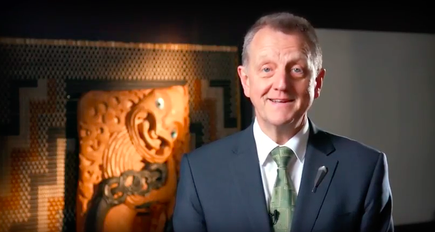
Empires have fallen over because they did not serve their citizens
Government Digital Services Minister Clare Curran says there are many schools of thought on what actually makes a thriving digital nation.
“For us in New Zealand, it is about making sure all our people are thriving in a digital world; that all Kiwis are on this journey with us; and that we shape the future together,” say Curran.
“This means being a country that leverages data, technologies, and digital skills to realise a more responsive, efficient and participatory government and ensure we have a thriving economy and society,” says Curran, in her keynote at the Digital Nations 2030 conference in Auckland.
“It means taking some risks, moving away from old paradigms that are no longer effective; re-imagining government’s role and relationship with citizens and industry; working with and showing leadership to industry and communities where technology the driver of a thriving, agile, intelligent, compassionate digital nation that leaves no-one out.”
The conference is part of Digital 5 (D5), the 4th annual gathering of the world's most advanced digital nations.
D5 is composed of New Zealand, Estonia, Israel, South Korea and the UK.
“This is the fourth annual gathering of D5 countries and I am delighted New Zealand is hosting it for the first time,” says Curran.
“I am proud that New Zealand is seen as a world leader when it comes to digital government,” she says.
There are areas that New Zealand can do better, she notes. “We still have room to better take advantage of digital opportunities to be an innovative, progressive and equitable country that is responsive and resilient in our changing world.”

How can we equip our young people for the jobs of the future? How can we ensure that we’ve got a modern teaching workforce? How can we ensure there are ongoing opportunities for life-long learning and re-training?
She says it is also important to be clear about what we want to achieve for a digital New Zealand.
“And it makes absolute sense to have an overarching vision across my roles – a vision that ‘all New Zealanders are thriving in a digital world’.”
She shares the Maori concept of tūrangawaewae – which means the place where a person feels empowered and connected.
“In an increasingly digital environment, this sense of foundation and connection can easily disappear. So it is important to me that we create a country where people are as at home online as they are in the real world.”
Curran reiterates the top goals for New Zealand in the digital economy, which are, to close the digital divides by 2020, and make ICT the second largest contributor to GDP by 2025.
“Collaboration is key. None of us has all the answers and we need to work together to come up with the best solutions to ensure we have thriving digital nations,” she says.
“We also need to think about just what government can do. How can government, NGOs and business work together to get the best possible outcomes for our nations?
“How can we equip our young people for the jobs of the future? How can we ensure that we’ve got a modern teaching workforce? How can we ensure there are ongoing opportunities for life-long learning and re-training?”
Leading the way
Siim Sikkut, government CIO of Estonia, told delegates about some of the programmes that had it named by the magazine ‘Wired’ as the most advanced digital society in the world.
“We are a modest country that extends beyond its borders,”he says. “We are bloody efficient on how we do things.”
Estonia has a population of 1.3 million, and nearly every one of them has a digital ID providing digital access to all of the country’s secure e-services. These include banking, signing documents or getting a medical prescription.
“Only marriage, divorce and selling your house are not digital,” he says.
He also cites the ease of doing business in Estonia. It takes only a few hours to start a company in Estonia and all reporting is done online. “That is why startup companies go to Estonia.”
He says the “busiest highway” in Estonia is X-Road, which holds the nation’s various e-databases both in the public and private sectors.
We worked across agencies to have the data linked up, saving the government and citizens time, says Sikkut. “The data is there, we reuse it.”
“We have to continue to improve the way citizens experience their government services on a day to day basis,” notes Colin MacDonald, chief executive, Secretary for Internal Affairs; Secretary for Local Government; and NZ government chief digital officer.

“Empires have fallen over in the past because they did not serve their citizens,” he says.
“How government uses digital models of engagement, digital models of decision making to listen and to manage risks and spread opportunities” are among the issues we need to move to from a government perspective.

It takes only a few hours to start a company in Estonia and all reporting is done online. That is why startup companies go to Estonia.
Future of work
Andrew Grant, senior partner for McKinsey in Singapore, says the foremost challenge for the future of work is not reskilling but inequality.
Digital and artificial intelligence is going to make it a much more fundamental challenge, he adds.
Jobs are going to go away but jobs are going to be created, he points out.
“It is the taking away of tasks and recreation of careers that is going to be the most fundamental change in the future of work.”
“The institutions we have today are not just set up to take the metabolic rate of change we have to deal with.”
Leaders have to make a commitment no one will be left behind, he says. “Everyone of our employees will be reskilled, retrained, we will make a commitment as a city, as a country, as an economy, that no one is left behind.”
The secret to digital success
Graham Waller, a research vice president at Gartner, talks about the leadership and people component around leading digital transformation.
“The secret to digital is analogue, and by analogue we mean people,” says Waller.
He says leaders across across functions in public and private sector interviewed by Gartner say access to skills, talents and digital competencies are the big barriers to change.

Our systems are not set up for breakthrough and transformative leadership, they are designed for stability and incremental change
“Unfortunately our systems are not set up for breakthrough and transformative leadership,” he points out. “In fact they are designed for stability and incremental change.”
He uses the metaphor of a fighter jet where conventional wisdom points to the need to design it for aerodynamic stability. This is to keep the jet in the air.
The breakthrough development was when engineers designed for deliberate instability to make the jet more maneuverable and to drive better outcomes.
He says it is the same for digital transformation.
How do we design the end to end system for agility? This can be done by embracing a new mindset and the disciplines and techniques of the digital world. These include lean, startups, minimum viable product and business experimentation.
Digital dexterity, or the desire and ability to harness technology to drive a new outcome is important, he says.
We need to look at the mindsets of our leaders, middle management and the workforce, he states.
The need is to change the mindset to go after transformational change, be more risk tolerant, and to collaborate more broadly across public and private sectors, he concludes.
Learn from your peers: Check out our State of the CIO report on the challenges and concerns of CIOs today. Sign up for CIO newsletters for regular updates on CIO news, career tips, views and events. Follow CIO New Zealand on Twitter:@cio_nz Join us on Facebook.
Join the CIO New Zealand group on LinkedIn. The group is open to CIOs, IT Directors, COOs, CTOs and senior IT managers.
